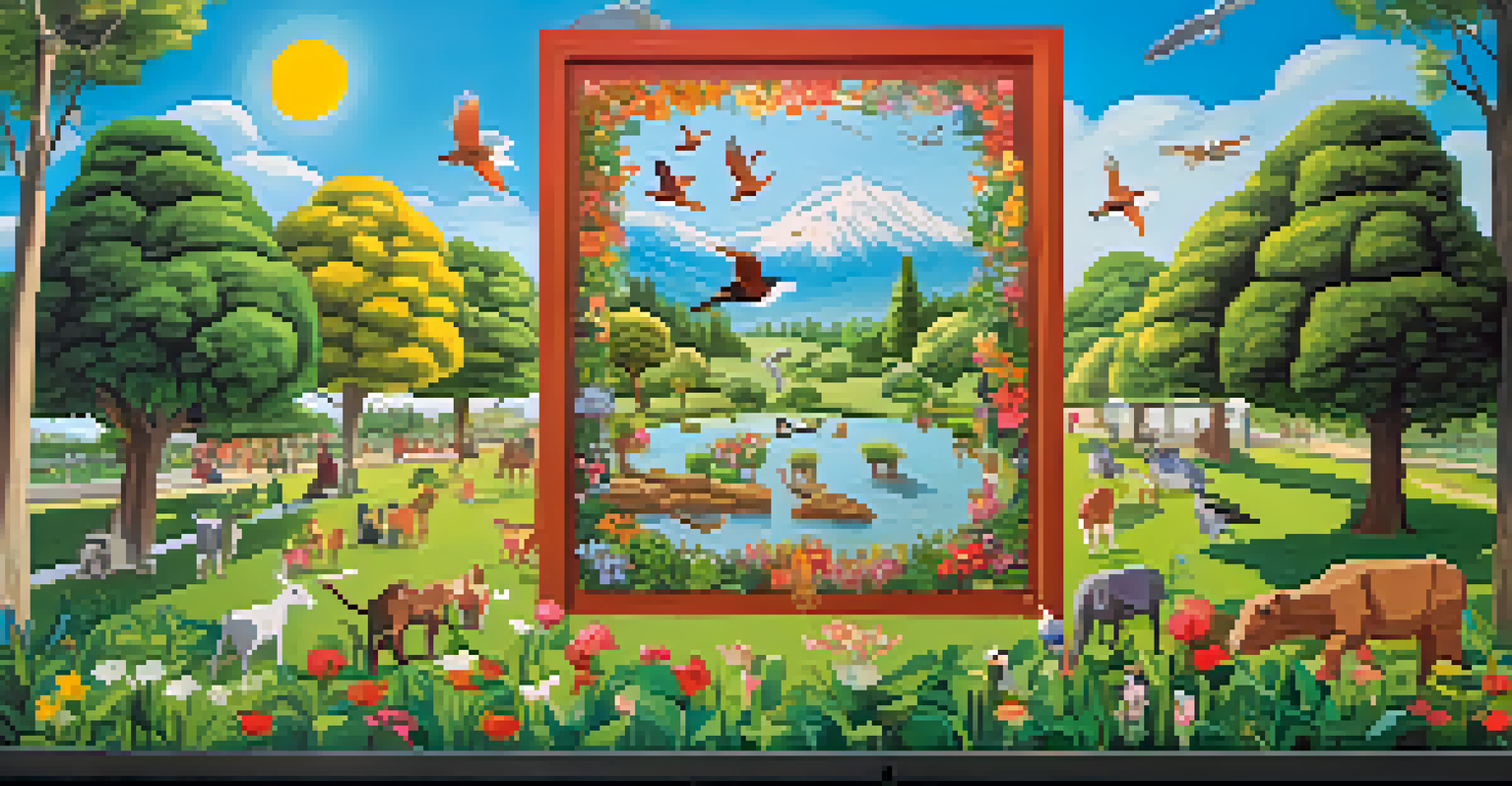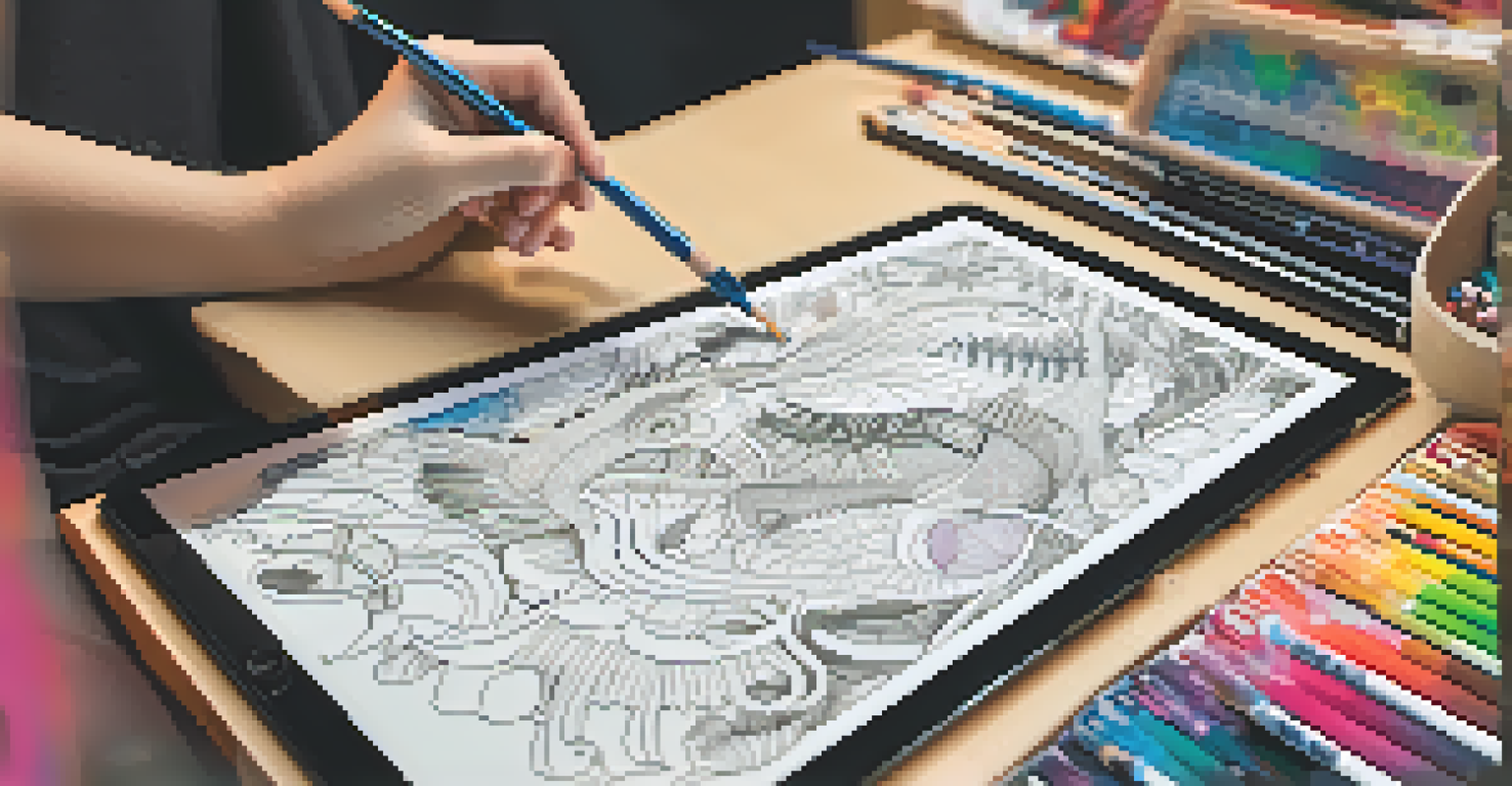Integrating Augmented Reality in Creative Art Lessons

What is Augmented Reality in Art Education?
Augmented Reality (AR) blends digital elements with the real world, enhancing our perception of reality. In art education, it allows students to interact with digital artworks superimposed over physical canvases. Imagine a student painting a landscape and then viewing a virtual butterfly fluttering above it, creating a magical experience.
Art is not freedom from discipline, but disciplined freedom.
This technology harnesses smartphones or tablets to bring static images to life, making the learning process more engaging. By using AR, educators can introduce new concepts in a visually stimulating way, encouraging students to think creatively. It’s like having an artistic assistant who can illustrate ideas right before your eyes.
Moreover, AR can cater to various learning styles, whether visual, auditory, or kinesthetic. This inclusivity can help students who might struggle with traditional methods. Ultimately, integrating AR into art lessons can foster curiosity and inspire students to explore their creativity.
Benefits of Using AR in Creative Art Lessons
One of the main benefits of AR in art education is its ability to enhance engagement. When students use AR, they often find the learning experience more exciting and interactive. This heightened engagement can lead to improved retention of information and a deeper understanding of artistic concepts.

Additionally, AR promotes collaboration among students. They can work together to create mixed-media projects that blend traditional techniques with digital enhancements. This teamwork not only builds social skills but also encourages an exchange of ideas, leading to innovative outcomes.
AR Enhances Engagement in Art Education
Augmented Reality makes learning more interactive and exciting, leading to better retention and understanding of artistic concepts.
Furthermore, AR can make art history more accessible. Students can view famous artworks in 3D, explore their details, and even interact with the context of the pieces. This immersive experience can spark discussions that go beyond surface-level analysis, enriching their appreciation for art.
Tools and Apps for Integrating AR in Art Lessons
There are various tools and apps designed specifically for integrating AR into art lessons. For instance, platforms like Artivive allow students to create artwork that comes to life through a smartphone camera. This app is user-friendly and can be easily incorporated into classroom activities, making it a favorite among educators.
Technology is best when it brings people together.
Another popular option is Google Arts & Culture, which offers an array of AR experiences related to famous artworks and artists. Students can explore these artworks up close, gaining insights that traditional textbooks might not provide. It's like taking a virtual field trip to a museum without leaving the classroom!
Additionally, some AR drawing apps, such as Quiver, let students color printed pages that then animate on screen. This hands-on approach can encourage younger students to express their creativity while learning about colors, shapes, and art fundamentals. With the right tools, the possibilities for creativity are endless.
Incorporating AR into Lesson Plans Effectively
To successfully incorporate AR into art lessons, it’s essential to have clear objectives. Educators should define what they want students to learn and how AR can facilitate that process. For example, if the goal is to teach color theory, using AR to visualize color mixing can be particularly effective.
Another key aspect is to ensure that technology is accessible to all students. This may involve having enough devices for group work or teaching students how to use their own smartphones responsibly. When everyone can participate equally, the benefits of AR become more pronounced.
AR Tools Foster Creativity and Collaboration
Using AR in art lessons promotes teamwork among students and encourages them to explore their creativity through innovative projects.
Finally, it’s important to encourage creativity and exploration. Allow students to experiment with AR tools in their own way, giving them the freedom to express their ideas. This autonomy can lead to unique projects that reflect their individual artistic voices, making the learning experience even more rewarding.
Overcoming Challenges in AR Art Education
While integrating AR into art lessons offers numerous benefits, it can also present challenges. One common issue is the potential for technical difficulties, such as software glitches or connectivity problems. Educators can mitigate this by thoroughly testing tools before lessons and having a backup plan in case of issues.
Another challenge is the need for adequate training for teachers. Understanding how to use AR tools effectively is crucial for maximizing their potential in the classroom. Providing professional development opportunities can empower educators to embrace this technology confidently.
Lastly, some students may initially feel overwhelmed by the new technology. It’s essential to create a supportive environment where they can ask questions and seek help. With patience and guidance, students will likely adapt and thrive, enhancing their artistic journey.
Real-World Examples of AR in Art Education
Several schools and institutions have successfully integrated AR into their art curricula. For example, a middle school in California implemented an AR program where students created a mural that came to life through an app. This project not only engaged the students but also fostered a sense of community pride.
Another inspiring example is a high school in New York that used AR to explore famous artists and their techniques. Students created digital portfolios showcasing their work alongside AR-enhanced images, allowing them to present their projects in a unique way. This blend of traditional and digital art sparked excitement and creativity.
The Future of AR in Art Looks Bright
As technology advances, AR will increasingly integrate into art education, preparing students for a creative and tech-savvy future.
These real-world examples illustrate how AR can transform art education, making it more dynamic and relevant. As more schools adopt this technology, the potential for innovative teaching methods will continue to grow, inspiring the next generation of artists.
The Future of AR in Art Education
Looking ahead, the future of AR in art education appears bright. As technology continues to evolve, we can expect even more sophisticated tools that will further enhance the learning experience. New developments may include more interactive environments or even the ability to collaborate with artists worldwide in real-time.
Moreover, the growing interest in STEAM (Science, Technology, Engineering, Arts, and Mathematics) education emphasizes the importance of integrating technology into the arts. AR aligns perfectly with this movement, encouraging students to embrace their creativity while also developing technical skills that are increasingly valuable in today’s job market.

Ultimately, as educators and students become more familiar with AR, it will likely become an integral part of art education. By nurturing creativity and innovation, we can prepare students not just for artistic success but for a world that increasingly values creativity in all its forms.